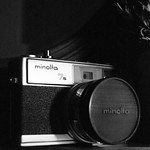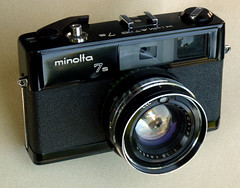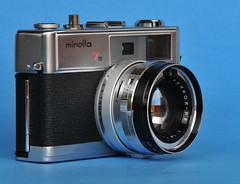Difference between revisions of "Minolta Hi-Matic 7s"
(Created a page for the Hi-matic 7s, thus, removing the re-direct to the Hi-matic 7) |
Hanskerensky (talk | contribs) m (Now Category:H|Hi-Matic 7s Minolta) |
||
| (13 intermediate revisions by 4 users not shown) | |||
| Line 1: | Line 1: | ||
| − | {{Camera| | + | {{Camera|cameraName = {{PAGENAME}} |
| dateProduction = 1966 | | dateProduction = 1966 | ||
| − | | image_source = | + | | image_source = https://www.flickr.com/photos/claudioarriens/45088570094/in/pool-camerawiki/ |
| − | | image = http:// | + | | image = http://farm5.staticflickr.com/4901/45088570094_aabfacddff.jpg |
| − | | image_text = Minolta Hi-Matic 7s <br><small>by {{image author| | + | | image_text = Minolta Hi-Matic 7s <br><small>by {{image author|Claudio Arriens}}</small> {{non-commercial}} |
| manu = [[Minolta]] | | manu = [[Minolta]] | ||
| type = [[Rangefinder camera]] | | type = [[Rangefinder camera]] | ||
| Line 18: | Line 18: | ||
| mrange = EV 5.7 (f/1.8 at 1/15 sec) to EV 17 (f/22 at 1/250 sec) | | mrange = EV 5.7 (f/1.8 at 1/15 sec) to EV 17 (f/22 at 1/250 sec) | ||
| mmode = | | mmode = | ||
| − | | focusing = Direct helicoid focusing coupled to a super-imposed rangefinder | + | | focusing = Direct helicoid focusing coupled to a super-imposed rangefinder; closest focusing distance is 0.9m (3ft) |
| farea = | | farea = | ||
| flash = [[hot shoe]] and PC socket | | flash = [[hot shoe]] and PC socket | ||
| Line 37: | Line 37: | ||
}} | }} | ||
| − | |||
| − | |||
| − | |||
| − | |||
| − | |||
== Features of the Hi-Matic 7s == | == Features of the Hi-Matic 7s == | ||
| − | + | {|class=floatleft | |
| − | + | | | |
{{Flickr_image | {{Flickr_image | ||
| − | |image_source= http://www.flickr.com/photos/98922823@N00/4510755956/in/pool-camerawiki | + | |image_source= http://www.flickr.com/photos/98922823@N00/4510755956/in/pool-camerawiki |
|image= http://farm3.staticflickr.com/2102/4510755956_8462b41afb_m.jpg | |image= http://farm3.staticflickr.com/2102/4510755956_8462b41afb_m.jpg | ||
|image_align= left | |image_align= left | ||
| Line 53: | Line 48: | ||
|image_by= Paulo Moreira | |image_by= Paulo Moreira | ||
|image_rights= with permission | |image_rights= with permission | ||
| + | }} | ||
| + | |} | ||
| + | The Hi-Matic 7s and [[Minolta Hi-Matic 9 | Hi-Matic 9]] followed the [[Minolta Hi-Matic 7|H-Matic 7]] in 1966, and were improved versions of the 7. Briefly, the cameras were rangefinder focusing, with automatic exposure, plus manual control guided by a viewfinder meter pointer that registered against an EV scale. | ||
| + | |||
| + | The 7s came with the Contrast Light Compensator (CLC) metering system, but how it works in Hi-Matic cameras is unclear. The 7s also added a hot shoe and Safe Load System (SLS) indicator to show that film was loaded and being transported properly. Additional differences between the 7 and 7s included rangefinder windows changing from a contrasting 'pink and green' tint to 'yellow and blue'; the carrying strap lugs moving up to the side and given a more rounded shape; and the end of the lens barrel being black rather than the brushed aluminium of the 7. The 7s also came in a black version. | ||
| + | {{brl}} | ||
| + | == CLC == | ||
| + | {{Flickr_image | ||
| + | |image_source= https://www.flickr.com/photos/zionfiction/4757746619/in/pool-camerawiki | ||
| + | |image= http://farm5.staticflickr.com/4120/4757746619_c8c0e22817_q_d.jpg | ||
| + | |image_align= right | ||
| + | |image_text= | ||
| + | |image_by= R. Nial Bradshaw | ||
| + | |image_rights= cc | ||
}} | }} | ||
| − | + | In some other Minolta cameras of the period, such as the [[Minolta_SRT_101|SR-T 101]], the CLC was a device that used two CdS cells to identify contrast (illumination level differences) at the top and bottom (in landscape format) of a scene. Where these differences are minimal, the exposure value is averaged. Where there is a significant difference, the exposure is weighted to favour increased exposure of the darker half of the scene. The Hi-Matic cameras of the 1960s had a single light cell, but nevertheless bore a CLC badge, and the precise nature of the contrast light compensator is unclear. | |
| + | |||
| + | Prior to introduction of these models, Minolta registered a patent for a lens mounted CdS cell to be given an off-the-lens-axis viewpoint, via the use of a cell covering lens, and blinds to narrow the field of view<ref> [https://www.google.com/patents/US3286609?dq=inassignee:%22Minolta+Camera+Kk%22&hl=en&sa=X&ved=0ahUKEwiSzafv_trSAhWD6yYKHSu0BFYQ6AEIITAB Patent 3,286,609]</ref>. This could favour exposure of the lower area of a view, and therefore passively compensate for anticipated brighter components, such as the sky. It is speculated that this is the nature of the CLC in Hi-Matics. | ||
| + | Minolta advertising of the time generally plays-down the CLC, or simply does not mention it. | ||
== Evaluation == | == Evaluation == | ||
| Line 62: | Line 74: | ||
{|class="wikitable" | {|class="wikitable" | ||
|+45mm F/1.8 Rokkor-PF | |+45mm F/1.8 Rokkor-PF | ||
| + | |rowspan=9| | ||
| + | {{Flickr_image | ||
| + | |image_source= https://www.flickr.com/photos/heritagefutures/4649300616/in/pool-camerawiki | ||
| + | |image= http://farm4.staticflickr.com/3309/4649300616_503ef69e23_m.jpg | ||
| + | |image_align= left | ||
| + | |image_text= | ||
| + | |image_by= Dirk HR Spennemann | ||
| + | |image_rights= wp | ||
| + | }} | ||
! Aperture | ! Aperture | ||
! Center<br />Sharpness | ! Center<br />Sharpness | ||
| Line 108: | Line 129: | ||
{|class=plainlinks | {|class=plainlinks | ||
||[http://www.flickr.com/photos/50678983@N00/237653796/in/pool-camerawiki/ http://static.flickr.com/79/237653796_9386100a5a_t.jpg] | ||[http://www.flickr.com/photos/50678983@N00/237653796/in/pool-camerawiki/ http://static.flickr.com/79/237653796_9386100a5a_t.jpg] | ||
| + | ||[http://www.flickr.com/photos/50678983@N00/237653798/in/pool-camerawiki/ http://static.flickr.com/83/237653798_e64520d3b5_t.jpg] | ||
||[http://www.flickr.com/photos/50678983@N00/237653805/in/pool-camerawiki/ http://static.flickr.com/81/237653805_d4f1f779ec_t.jpg] | ||[http://www.flickr.com/photos/50678983@N00/237653805/in/pool-camerawiki/ http://static.flickr.com/81/237653805_d4f1f779ec_t.jpg] | ||
||[http://www.flickr.com/photos/50678983@N00/237653790/in/pool-camerawiki/ http://static.flickr.com/91/237653790_779a83c60f_t.jpg] | ||[http://www.flickr.com/photos/50678983@N00/237653790/in/pool-camerawiki/ http://static.flickr.com/91/237653790_779a83c60f_t.jpg] | ||
||[http://www.flickr.com/photos/50678983@N00/237653801/in/pool-camerawiki/ http://static.flickr.com/62/237653801_40dabb0d25_t.jpg] | ||[http://www.flickr.com/photos/50678983@N00/237653801/in/pool-camerawiki/ http://static.flickr.com/62/237653801_40dabb0d25_t.jpg] | ||
| + | |rowspan=2 valign=top| | ||
| + | {{Flickr_image | ||
| + | |image_source= https://www.flickr.com/photos/peterlerman/5920025216/in/pool-camerawiki | ||
| + | |image= http://farm7.staticflickr.com/6121/5920025216_a120262c1c_t_d.jpg | ||
| + | |image_align= right | ||
| + | |image_text= | ||
| + | |image_by= Peter Lerman | ||
| + | |image_rights= wp | ||
| + | }} | ||
|- | |- | ||
| − | | colspan= | + | | colspan=5 align=center | |
| − | The | + | The '''Hi-Matic 7s'''<br/><small>images by {{image author|Dries van den Elzen}}</small> {{with permission}} |
|} | |} | ||
| − | + | {{br}} | |
| − | |||
== Links == | == Links == | ||
| Line 122: | Line 152: | ||
* [http://en.wikipedia.org/wiki/Minolta_Hi-Matic Minolta Hi-matic at Wikipedia] | * [http://en.wikipedia.org/wiki/Minolta_Hi-Matic Minolta Hi-matic at Wikipedia] | ||
* [http://www.butkus.org/chinon/minolta/minolta_hi-matic_7s/minolta_hi-matic_7s.htm Minolta Hi-matic 7s manual by Mike Butkus] | * [http://www.butkus.org/chinon/minolta/minolta_hi-matic_7s/minolta_hi-matic_7s.htm Minolta Hi-matic 7s manual by Mike Butkus] | ||
| − | |||
| Line 129: | Line 158: | ||
[[Category: 1966]] | [[Category: 1966]] | ||
[[Category: M]] | [[Category: M]] | ||
| − | [[Category: H|Hi-Matic 7s]] | + | [[Category:H|Hi-Matic 7s Minolta]] |
Latest revision as of 07:15, 24 January 2022
| Minolta Hi-Matic 7s |
|---|
|
Manufacturer: Minolta
Film type: 35mm
|
Features of the Hi-Matic 7s
|
The Hi-Matic 7s and Hi-Matic 9 followed the H-Matic 7 in 1966, and were improved versions of the 7. Briefly, the cameras were rangefinder focusing, with automatic exposure, plus manual control guided by a viewfinder meter pointer that registered against an EV scale.
The 7s came with the Contrast Light Compensator (CLC) metering system, but how it works in Hi-Matic cameras is unclear. The 7s also added a hot shoe and Safe Load System (SLS) indicator to show that film was loaded and being transported properly. Additional differences between the 7 and 7s included rangefinder windows changing from a contrasting 'pink and green' tint to 'yellow and blue'; the carrying strap lugs moving up to the side and given a more rounded shape; and the end of the lens barrel being black rather than the brushed aluminium of the 7. The 7s also came in a black version.
CLC

|
| image by R. Nial Bradshaw (Image rights) |
In some other Minolta cameras of the period, such as the SR-T 101, the CLC was a device that used two CdS cells to identify contrast (illumination level differences) at the top and bottom (in landscape format) of a scene. Where these differences are minimal, the exposure value is averaged. Where there is a significant difference, the exposure is weighted to favour increased exposure of the darker half of the scene. The Hi-Matic cameras of the 1960s had a single light cell, but nevertheless bore a CLC badge, and the precise nature of the contrast light compensator is unclear.
Prior to introduction of these models, Minolta registered a patent for a lens mounted CdS cell to be given an off-the-lens-axis viewpoint, via the use of a cell covering lens, and blinds to narrow the field of view[1]. This could favour exposure of the lower area of a view, and therefore passively compensate for anticipated brighter components, such as the sky. It is speculated that this is the nature of the CLC in Hi-Matics. Minolta advertising of the time generally plays-down the CLC, or simply does not mention it.
Evaluation
Modern Photography evaluated the Hi-Matic 7s in 1967 after its release.[2] In general they noted that it operated similarly to the Hi-Matic 7. They found that CLC meter was within 1/2 stop of their test reference, and field tests with transparencies were well exposed despite a variety of light and contrast. They also liked that the meter could be switched off to prevent battery drain, and they liked the SLS indicator, which not only showed that the film had been loaded correctly but also tracked film usage. Because the lens of the 7s was the same as the 7, Modern Photography did no lens test of the 7s, and simply repeated the lens test results of the 7.[3]
|
Aperture | Center Sharpness |
Edge Sharpness | ||
|---|---|---|---|---|---|
| 1.8 | Good | Acceptable | |||
| 2.8 | Good | Acceptable | |||
| 4 | Good | Good | |||
| 5.6 | Good | Good | |||
| 8 | Good | Very Good | |||
| 11 | Good | Very Good | |||
| 16 | Good | Very Good | |||
| 22 | Acceptable | Good |
References
- ↑ Patent 3,286,609
- ↑ "More automation comes to Hi-matic," Modern Photography, October 1967, 84.
- ↑ "Minolta Hi-matic 7: through-lens metering," Modern Photography, July 1964, 78-79.
Pictures

|

|

|

|

|
| ||
|
The Hi-Matic 7s | |||||||



